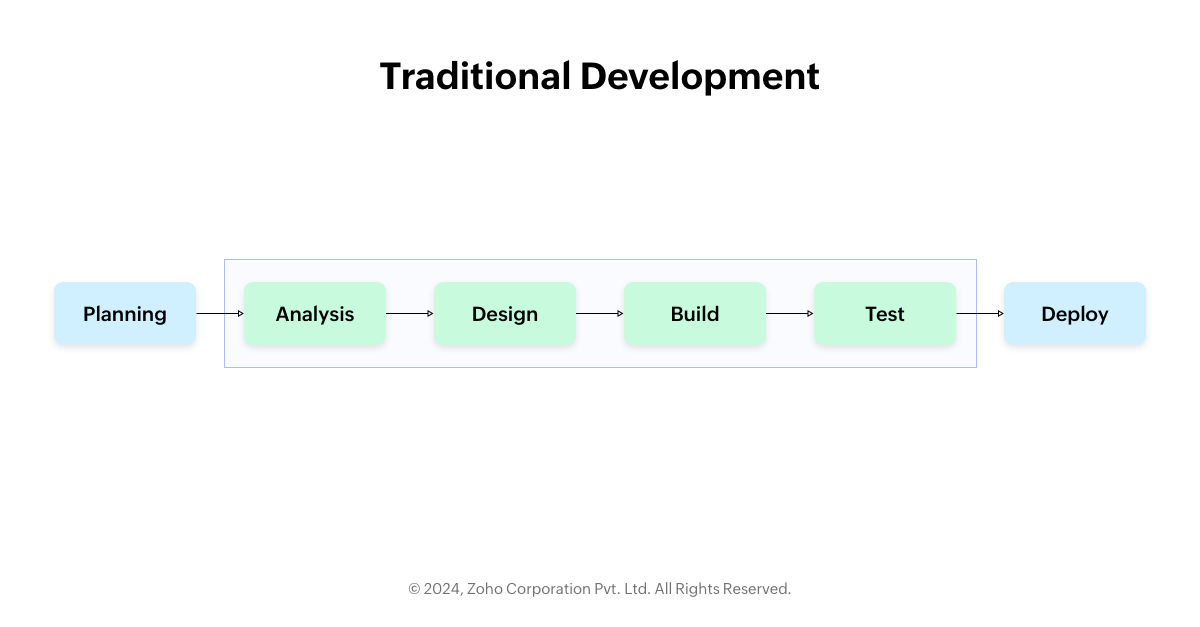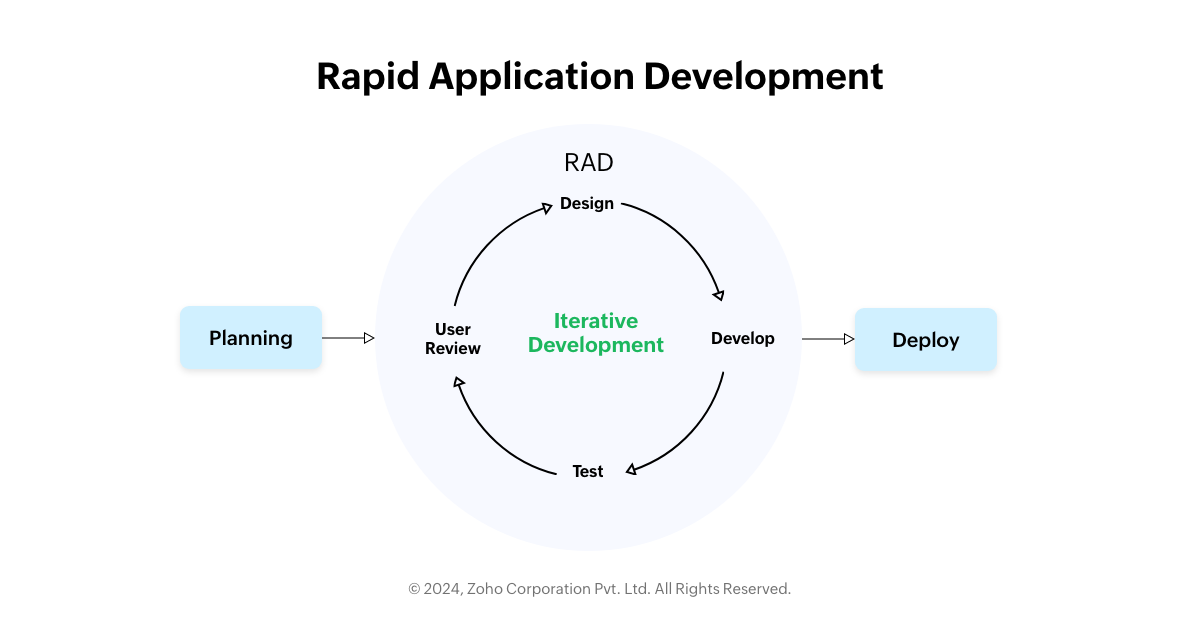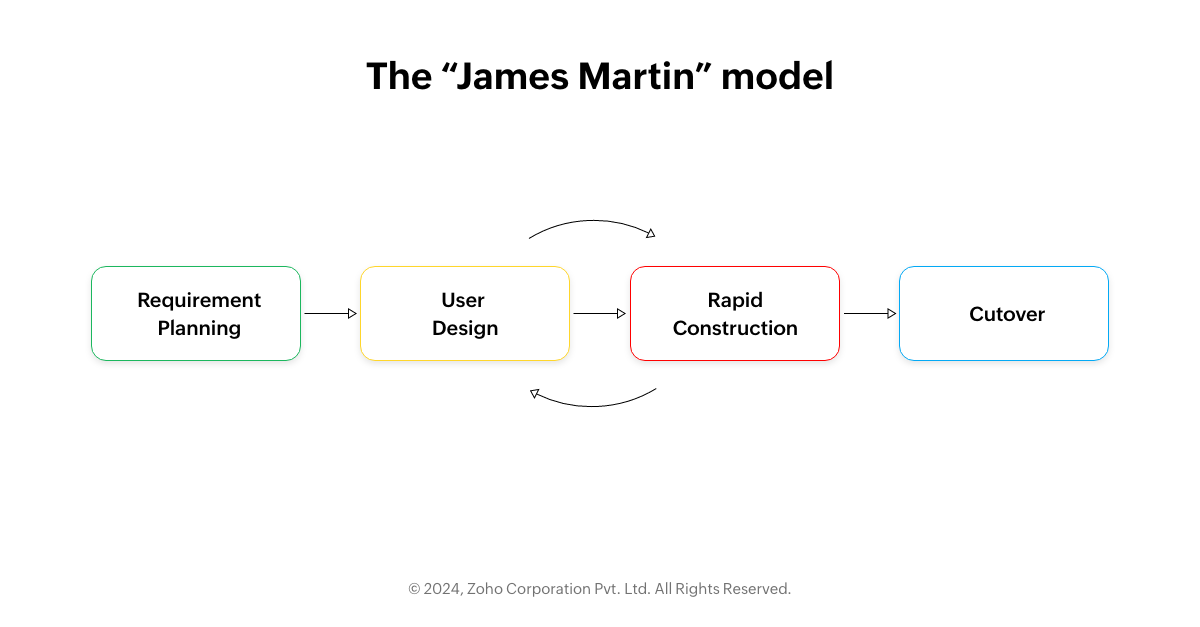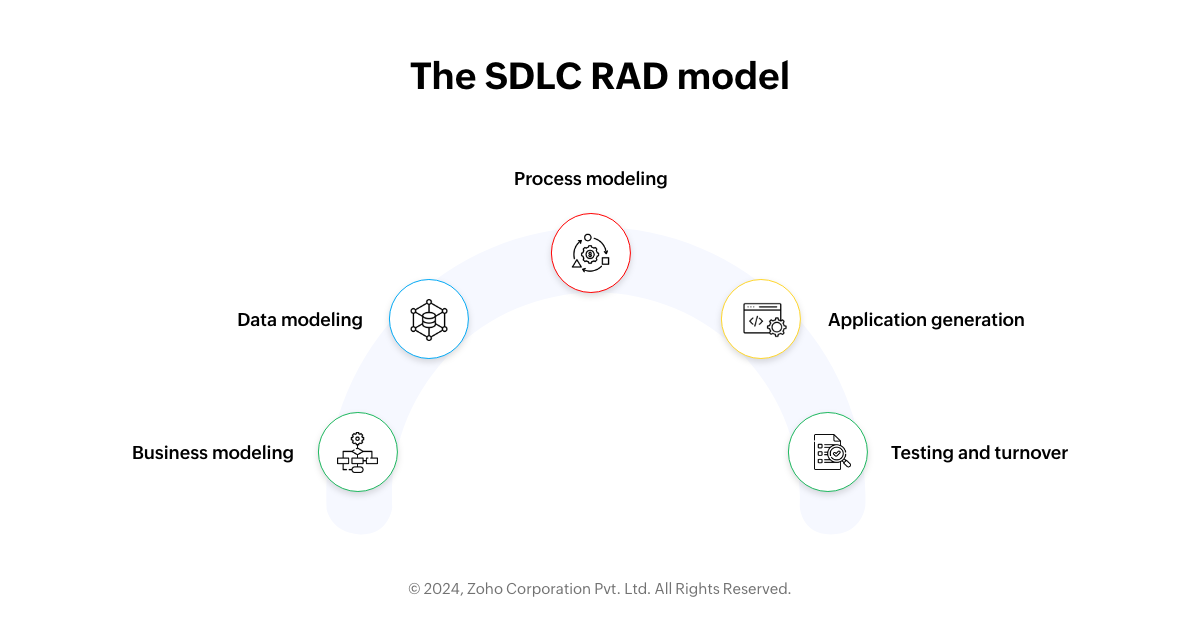- HOME
- Know Your Tech
- Understanding rapid application development methodology
Understanding rapid application development methodology
- Last Updated : September 20, 2024
- 1.2K Views
- 9 Min Read
The world of application development is shifting gears. In 2022, the rapid application development market was valued at $49.8 billion USD. However, by 2030, it's expected to reach $802.8 billion, growing at a lightning-fast pace of 41% each year.
But why the sudden need for speed? In this blog, we'll explore rapid application development (RAD) methodology and uncover why this accelerated approach is suitable for building better applications in a shorter timeframe.
What is rapid application development?
Rapid application development, also known as RAD, is a software development process or methodology (not a model) that prioritizes speed. It focuses on building prototypes quickly, incorporating continuous testing throughout the process, and actively seeking end-user feedback to refine the application. Instead of focusing on the process, interactions and collaborations between different people from technology and business teams become the emphasis.
This iterative approach ensures you're building what users actually need, all while keeping development moving at a rapid pace.
In the tech world, the term rapid application development can be confusing; it's not a specific model per se, but it refers to the broader shift away from the waterfall model.
A brief history of rapid application development
Rapid application development was a response to the sequence-driven waterfall model developed in the 1980s. Why? Because the waterfall model was inspired by the structured, sequential approach used in building bridges and skyscrapers. It assumed requirements were set in stone, making changes later in the process expensive and time-consuming.

In bridge construction, a blueprint dictates the final product—deviations are expensive and risky.
Software, however, is inherently adaptable. As Frederick P. Brooks Jr. famously stated in his 1986 book No Silver Bullet, "Software is pure-thought stuff, infinitely malleable", meaning that software is fluid and can be easily changed. RAD embraces this notion, allowing developers to adapt and improve throughout the development process.

Pioneered by Barry Boehm with his spiral model, rapid application development software focuses on prototyping over lengthy software specification documents. James Martin then built upon these ideas at IBM, formalizing them in his 1991 book Rapid Application Development. Slowly, RAD methodology gained traction as a powerful alternative to traditional software development methodologies.
Rapid app development, as we know it today, prioritizes rapid prototyping and feedback from end users—a stark contrast to the waterfall model's rigid structure. This shift has revolutionized the software development landscape, allowing for faster creation of better applications.
What are the different phases involved in rapid application development?
Rapid application development methodology isn't a one-size-fits-all approach. There are different ways to structure the development process within the RAD methodology. In this section, we'll dive into the two most well-known RAD models. But before that, let's look at the core of rapid application development models.
Core phases of a rapid application development model
While there are variations, both models share some core phases that ensure rapid application development and user involvement:
Requirements gathering
This phase focuses on identifying and understanding the needs of the users and the business. This will set a clear objective for all stakeholders involved.
User modeling
In this phase, a clear picture of the target user is developed. This includes understanding their goals, workflows, and challenges.
Prototyping
This is the most important part of RAD. Functional prototypes or POCs (proofs of concept) that mimic the final application are built quickly, allowing users to interact with them and provide feedback. These prototypes are not meant to be perfect, but serve as a foundation for iteration based on testing.
Construction
Based on user feedback, the prototypes are refined and developed into the final application. This phase involves coding, system testing, and integration of various components.
Deployment
The final application is deployed to the users. Training, documentation, and maintenance are taken care of during this phase.
Now, let's explore the specific phases of each RAD model, to see how they handle these core activities differently.
The "James Martin" model
This model is a more technical approach, focusing on rapid application development cycles:
1. Requirement planning phase
2. User design phase
3. Rapid construction phase
4. Cutover phase
Unlike traditional software development methods with extensive requirements planning, RAD embraces an iterative approach. Here, the focus shifts to building an efficient prototype. This prototype becomes the cornerstone for collecting feedback from end users. The prototype development and feedback gathering go in a loop until the end product is satisfactory to all stakeholders involved.
Requirement planning phase
In this phase of rapid application development, the stakeholders have to loosely define the requirements and plan the budget, expectations, and other outcomes of the application. Only the essential features have to be defined, as everything is subject to change in this model.
User design phase
In the next phase, the software development teams will have to build a functional prototype or POC of the application based on the gathered requirements. This POC will be tested and designed in iterations based on continuous feedback.

Rapid construction phase
During this phase, stakeholders and end users get to test the final working model and provide feedback. Sometimes, the prototype can help the developers realize they need to tweak their original requirements. Once the prototype is signed off on, the application is coded, developed, and tested, ensuring the requirements are met.
Cutover phase
In the cutover phase, the software development team takes the application from prototype to reality, moving it to a live production environment. Here, any necessary system testing, process documentation, maintenance tasks, or user training can take place.
The SDLC RAD model
Here are the five phases:
Business modelling
Data modeling
Process modeling
Application generation
Testing and turnover
Business modelling
In this phase, the information flow between different business functions is identified and gathered, including what information drives the business, what type of information is being generated, who generates it, who processes it, and where it gets stored.
Data modeling
The information obtained from the previous stage is analyzed and categorized into data objects (entities) based on how they benefit the business. The attributes (character entities) are identified, and the relationship between these data objects is defined.

Process modeling
In the third phase, information gathered during data modelling is converted into usable information. This is also the phase where you can fine-tune things. This includes defining exactly what data is needed and creating instructions for adding, removing, or changing that data.
Application generation
Here, the actual development, coding, integration, and testing takes place. The development team compiles all the information, data models, and processes gathered from the previous stages and converts them into a functional prototype.
Testing and turnover
Since the prototypes are independently tested during every iteration, only critical parts of the application that are newly added or data flow between different components are tested during this phase.
Rapid development methodology in today's software development landscape
The software development landscape is undergoing a massive transformation driven by two key trends—the explosion of mobile devices and the rise of cloud-based services. This means that businesses are no longer willing to invest in traditional methods that take months or even years to complete software development.
Rapid development methodology addresses this challenge by enabling quick app development cycles, allowing companies to bring innovative solutions to market faster. This birthed a need for skilled software developers who can leverage traditional methods and RAD tools to do more in less time.
From a developer perspective, RAD is becoming an increasingly attractive approach for many reasons, including:
Faster cycles - RAD allows developers to see their work come to life quicker, which can be motivating.
User-centric - In RAD, frequent user feedback loops ensure developers are building what users actually need.
Improved collaboration - The iterative nature of RAD fosters closer collaboration between developers, designers, and users.
Benefits and challenges of rapid application development methodology
Benefits
Speed
RAD breaks down projects into short, iterative cycles. This allows for early and consistent feedback and quicker refinement of the applications, leading to faster development.
Adaptability
The short development cycles of RAD make it easier to adapt to changing requirements. Frequent user feedback throughout the development cycle ensures the final product aligns with user needs and leads to a higher-quality application.
Transparency
RAD fosters frequent communication between stakeholders, ensuring everyone is on the same page and can collaboratively address issues for a product that meets business and technology needs.
Cost-savings
Reusable components and accelerated development processes reduce rework and development time, resulting in lower costs. Additionally, RAD helps avoid building unnecessary features through early user involvement.
Challenges
Skill gap
RAD relies heavily on skilled professionals who can leverage rapid application development tools effectively. If there aren't enough skilled developers on board, or they need to be extensively trained, it can be challenging to adhere to timelines.
Complex projects
Not all projects are suitable for RAD. Highly complex systems that can't be segregated based on components might struggle with the iterative nature of RAD.
Technical debt
The focus on rapid prototyping in RAD can sometimes lead to shortcuts in the initial stages. This can create technical debt (workarounds needing later fixes) that can impact development timelines.
When should you consider rapid application development for your business?
Rapid application development methods should be considered for applications that have straightforward requirements. They're not ideal for mission-critical software with high technical risks, though, where potential failures could have irreparable consequences.
Here are a few scenarios where you could opt for the rapid application development model:
Hackathonapps - RAD is highly suitable for hackathon and appathon setups, as innovative ideas can be transformed into reality within a tight timeframe. Most RAD platforms offer visual development and prebuilt components, thereby democratizing software development that lets participants from non-technical backgrounds take part in these events.
MVP creation for startups - RAD helps you secure funding faster, with a well-developed minimum viable product (MVP) built using a rapid application development cycle. This allows you to showcase core functionalities and refine the product based on investor feedback.
Self-service portals - RAD lets you quickly build and test self-service and customer portals where the requirements are fairly straightforward. Successful prototype testing in this scenario will mostly translate into the final product with minor refinements.
How do I know if my project is feasible for rapid application development?
If you are evaluating RAD for your project, keep the following points in mind:
Project scope
Well-defined goals and clear requirements are essential. While RAD allows for adjustments, a solid foundation is crucial for success.
Time constraints
Need to get things done quickly? RAD's rapid development cycle is perfect for projects with tight deadlines.
Project size
RAD is more suited for managing smaller, focused projects with a manageable team size since there'll be a lot of back and forth between the stakeholders.
Technical complexity
Projects with straightforward technical requirements are ideal for RAD. This allows developers to focus on core functionalities without getting bogged down in complex technical challenges.
What should you look for in ideal rapid application development tools?
Choosing the right RAD tool is crucial. Ideal tools should be user-friendly, allowing even those with limited coding experience to contribute. Here are five features you should consider before investing in a RAD tool:
Visual development
Think drag-and-drop and intuitive interfaces to build applications. RAD tools make app development faster and accessible to those with less coding experience.
Rapid prototyping
No more waiting months to see your application come to life. RAD tools let you build basic prototypes quickly, allowing you to gather user feedback early and iterate on your design. This ensures the final product meets actual user needs.
Code reusability
Why reinvent the wheel? Many RAD tools come with pre-built components and code snippets you can reuse across different applications. This saves loads of development time and reduces errors.
Customization options
Flexibility is key. The best RAD tools allow you to customize applications to your specific needs. This ensures your final product perfectly fits your unique requirements.
Scalability
Businesses grow, and their apps should too! Look for rapid development tools that can scale to handle increasing users and data volumes.
The Low-code advantage
Low-code platforms are a powerful type of rapid application development tool that includes all these features and more. Their core strength is empowering anyone, even those with limited coding experience, to create custom applications through user-friendly visual interfaces. This makes low-code platforms a popular choice for rapid application development, especially for businesses that need to build apps quickly without a large IT team.
Zoho Creator takes low-code development a step further. It offers a vast library of prebuilt applications for common tasks across various industries, from operations to sales. These readymade solutions give you a significant head start in the software development process, saving you time and effort. And the best part? You can customize these prebuilt apps to your specific needs, ensuring you get the functionality you require quickly.
With this approach to rapid application development, businesses can build the tools they need to thrive in any situation—and Zoho Creator can help you get there fast.
Click below to delve into the world of rapid application development.
 Swetha
SwethaHello! My name is Swetha, and I work as a Product Marketer at Zoho Creator. A typical day at work involves curating diverse content pieces, interacting with customers, and learning the latest marketing trends. When not at work, you can find me reading, talking to my cats, or exploring places. (She/her/hers)



